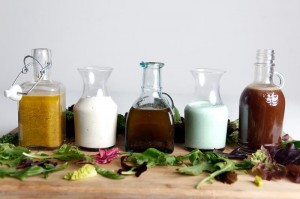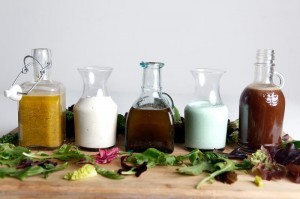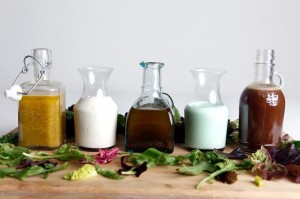 Flavorful salad dressings and sauces can bring healthy meals to a whole new level — they make vegetables, lean meats, whole-grain pastas, and salads taste even better. And since store-bought products can be loaded with fat, calories, and sodium, learning to make your own sauces and salad dressings is an important skill when it comes to preparing good-for-you dishes.
Flavorful salad dressings and sauces can bring healthy meals to a whole new level — they make vegetables, lean meats, whole-grain pastas, and salads taste even better. And since store-bought products can be loaded with fat, calories, and sodium, learning to make your own sauces and salad dressings is an important skill when it comes to preparing good-for-you dishes.
Follow these guidelines when going homemade:
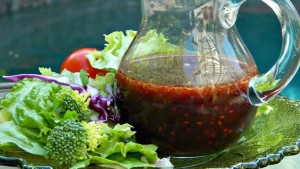 Use vinegar, not oil, as a dressing base.
Use vinegar, not oil, as a dressing base.
Make Homemade salad dressing with more vinegar, lemon juice, or orange juice than oil to keep calories in check. When making salad dressing, try varying your recipes with different flavored vinegar like Balsamic, sherry, or apple cider vinegar and oil like olive, walnut, flax, and sesame. It will satisfy your taste buds without adding a lot of extra fat.
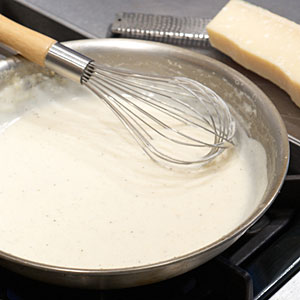 Swap heavy cream for lighter cheeses
Swap heavy cream for lighter cheeses
For a healthier version of creamy pasta sauces, use part-skim ricotta or soft goat cheese. Simply combine cooked pasta and veggies with a generous dollop of cheese, cracked black pepper, and a spoonful of the hot pasta cooking water (which helps thin out the cheese and turns it into a saucy consistency). This sauce is lower in calories and fat than heavy cream-based versions, and you get more protein and calcium from the cheese.
Rehab your favorites
For a better-for-you Alfredo sauce, use a similar technique buy using low-fat cottage cheese, blend one cup of low fat milk, 3/4 cup cottage cheese, 1/4 cup Parmesan cheese, a pinch of minced garlic, salt, and pepper. Then, add a pinch of basil and stir the sauce over a low heat until it reaches your desired consistency.
 Invest in a spice blend.
Invest in a spice blend.
When making homemade salad dressings, try this shortcut by using different spice blends like Country French Vinaigrette Mix from Penzys Spices — It has garlic, onion, tarragon, lemon, and other great flavorings. Simply whisk it into your vinegar and olive oil combo for a punch of flavor. Add a squirt of Dijon mustard to help emulsify the dressing. One of perks of going homemade is the ability to control the sodium level, which tends to be high in processed sauces. Since many spice blends contain salt, don’t forget to check labels for sodium content to keep levels in a healthy range. Choose fresh ingredients such as minced garlic over garlic powder and onion flakes over onion powder to further reduce sodium. In addition to seasonings, choose low-sodium or no-salt added tomato paste, or go with fresh tomatoes instead. A delicious low-sodium marinara can be created in a slow cooker with chopped fresh tomatoes, a bit of olive oil, oregano, sea salt, pepper, and garlic
 Skim off fat.
Skim off fat.
When you make a meat-based sauce, cool it in the refrigerator before you use it. This will allow you to separate out the fat. Simply skim the fat from the top of your sauce (where it will often harden) to dramatically reduce the fat content.
Use low-fat thickening agents.
Instead of using a butter-based roux to thicken a sauce, cut back on fat by thickening it with a small amount of cornstarch or flour. You can even get more creative and use silken tofu or pureed cashews and water as the base for creamy dressings and sauces.
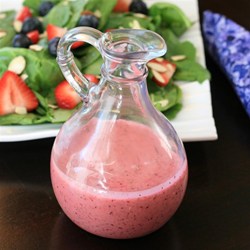 Up the creamy factor
Up the creamy factor
Nonfat Greek yogurt and pureed fruit are great for achieving the creamy consistency without all the fat or calories. For a healthier homemade version of blue cheese, combine one part blue cheese with two parts low-fat, plain Greek yogurt. Then add a splash of lemon juice, white vinegar to taste, and season with favorites like minced garlic, onion, pepper, and even basil. Or use avocado as a healthier fat source that will create a creamy dressing by blending it with one garlic clove, 1 tablespoon of olive oil, 1 tablespoon lime juice, and 1 tablespoon white vinegar. Then use as much water as needed to thin the dressing to your desired consistency and add a pinch of salt and pepper to taste. If you love a sweet salad, Fruits and veggies can easily make a homemade fruit dressing by blending together 1/4 cup pureed raspberries with 2 tablespoons olive oil, 1/3 cup apple cider vinegar, 1/2 teaspoon minced garlic, and a dash of salt and pepper.
Have containers of your favorite homemade salad dressings and sauces pre-made and ready to use when you need them to cut down on prep time during the week. You can keep a supply in the fridge for up to a week, and many sauces can be frozen.
Jump-start your healthy cooking with the homemade salad dressings and sauces in these recipes:
Citrus, Turkey, and Spinach Salad
Grilled Beef and Avocado Salad With Cilantro-Lime Vinaigrette
Hazelnut, Goat Cheese, and Tomato Salad With Chive Champagne Vinaigrette
Basic Basil Pesto
Horseradish-Dill Cream
Onion and Mushroom Gravy
Pork Medallions With Cranberry and Fig Chutney
Tomato Salsa Verde

